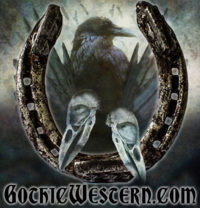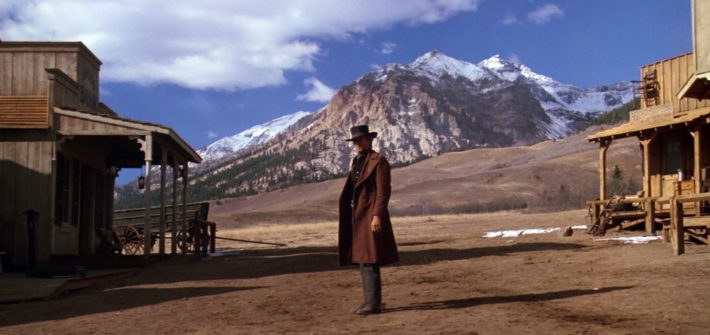The following is part two of a four part series by John Edgar Browning about Clint Eastwood’s Pale Rider (1985), taken from “Undead in the West II: They Just Keep Coming“, a book chronicling films in the Gothic Western and Weird Western genre. In this section Mr. Browning addresses Gothic Eurowesterns.
Gothic Eurowesterns
 Before examining Pale Rider as a Gothic American text, it is necessary first to outline, if only in general terms, a crucial body of Europeans films to supply a framework for our discussion. Evert Jan Van Leeuwen’s “Gothic Eurowesterns: A Grotesque Perspective on a Hollywood Myth” examines how Westerns filmed in southern Europe during the 1960s challenged the generic model in favor of a more gloomy, conflicted outlook— one that blurs the line between “right” and “wrong,” “good” and “evil.” Clint Eastwood’s career in cinematic Westerns began in such films, and the work is particularly instructive for understanding some of the major influences on Eastwood prior to his filming of High Plains Drifter (1973) and its spiritual successor Pale Rider. Leeuwen begins by contrasting Howard Hawks’s Rio Bravo (1959), a Western of the classic model, with Sergio Corbucci’s Django (1966), a Western of the conflicted model. T he setting of Rio Bravo, Leeuwen explains, “is a predominately bright world, peopled with brave cowboys, in control of their horses, who face the camera and the villains head-on to save the day, the settlement, and the civilization.” The West, Leeuwen adds, “is one of heroic sheriffs, defending beautiful young maidens in flowing dresses from evil outsiders.” In Django, however, we see, in the opening credits, “the back of a solitary black-clad figure, walking away from the camera through a sea of grey mud.” This enigmatic figure, Leeuwen continues, “is not on horseback, but carries the saddle for a horse he does not own. . . . The dark stranger is revealed to be pulling his own coffin on which [is] what looks like a solitary black candle.” The contrast between the classic American Western and Corbucci’s Eurowestern is deliberate, Leeuwen notes. The films are atmospherically and stylistically opposed to each other, with the European filmmakers appropriating classic Gothic tropes— a dark, mysterious wanderer and a dismal, depressing landscape like something out of Edgar Allan Poe’s “The Fall of the House of Usher”— “to challenge the dominant Hollywood myth of the American west” (note, however, that whereas Leeuwen argues for the inclusion of these Gothic tropes by European filmmakers as a means to “subvert the often utopian and mostly nostalgic ideological point of view of the classic American westerns,” the inclusion of such tropes in Pale Rider functions predominantly as a technology for representing and working through economic crisis, which, as Houston points out, is often imbued with supernatural qualities and, I have found, a certain level of “unrepresentability.”) Philip R. Loy writes that, in the classic American (that is, Hollywood) Western, “most folks were basically honest and brave but sometimes they needed a good leader to stiffen public resistance to the few who were corrupt and dishonest,” and violence is “socially necessary.” Films such as Rio Bravo and John Ford’s My Darling Clementine (1946), Fort Apache (1948), and She Wore a Yellow Ribbon (1949), Leeuwen notes, all pay homage to the notion of an “idyllic American West.” Christopher Frayling, however, points out that Sergio Leone’s interpretation of the American West is (as Leone accedes in an interview) that of an outsider and foreigner. A s an Italian and a descendant of the Romans, Leone depicted in his films a world under “the reign of violence by violence.” To Leeuwen, Leone’s “alternate vision” of the “American West” (situated in the Spanish countryside) represents what 220 John Edgar Browning Leeuwen calls “grotesque perspective.” Ambivalence, mated with the dissident union of binaries, is characteristic of the grotesque, observes Philip Thom son in The Grotesque (1972). Fundamental to Thomson’s notion of the grotesque, Leeuwen explains, is that the grotesque is not concerned with the creation of a fantasy world; it is not a purely aesthetic principle: “far from possessing a necessary affinity with the fantastic, the grotesque derives at least some of its effect from being presented within a realistic framework, in a realistic way.” (quoting Thomson) The elements that Thom son here emphasizes are also crucial to understanding Pale Rider, and I revisit them later. Leone, writes Leeuwen, peoples the grotesque worlds in his Dollars Trilogy— A Fistful of Dollars (1964), For a Few Dollars More (1965), and The Good, the Bad and the Ugly (1966)— using “grotesque individuals.” Absent from these characters is any clear sense of morality, overt heroism, or fundamental concern “with the welfare of the community and the nation.” Yet, curiously, it is the antihero with whom we come to identify most over the course of the film, resulting— perhaps intentionally— in no small amount of uncomfortable pleasure. The antihero figures in spaghetti Westerns, Frayling explains, are “usually identifiable by a collection of external gestures, mannerisms, stylish articles of clothing, or even motifs on the soundtrack, rather than anything remotely to do with the inner m an.” Eastwood’s antiheroic character in Leone’s spaghetti Westerns is lacking of nationality (statelessness) and personal history; he is even nameless. In this way, his identity is necessarily restricted almost entirely to his external characterization.
Before examining Pale Rider as a Gothic American text, it is necessary first to outline, if only in general terms, a crucial body of Europeans films to supply a framework for our discussion. Evert Jan Van Leeuwen’s “Gothic Eurowesterns: A Grotesque Perspective on a Hollywood Myth” examines how Westerns filmed in southern Europe during the 1960s challenged the generic model in favor of a more gloomy, conflicted outlook— one that blurs the line between “right” and “wrong,” “good” and “evil.” Clint Eastwood’s career in cinematic Westerns began in such films, and the work is particularly instructive for understanding some of the major influences on Eastwood prior to his filming of High Plains Drifter (1973) and its spiritual successor Pale Rider. Leeuwen begins by contrasting Howard Hawks’s Rio Bravo (1959), a Western of the classic model, with Sergio Corbucci’s Django (1966), a Western of the conflicted model. T he setting of Rio Bravo, Leeuwen explains, “is a predominately bright world, peopled with brave cowboys, in control of their horses, who face the camera and the villains head-on to save the day, the settlement, and the civilization.” The West, Leeuwen adds, “is one of heroic sheriffs, defending beautiful young maidens in flowing dresses from evil outsiders.” In Django, however, we see, in the opening credits, “the back of a solitary black-clad figure, walking away from the camera through a sea of grey mud.” This enigmatic figure, Leeuwen continues, “is not on horseback, but carries the saddle for a horse he does not own. . . . The dark stranger is revealed to be pulling his own coffin on which [is] what looks like a solitary black candle.” The contrast between the classic American Western and Corbucci’s Eurowestern is deliberate, Leeuwen notes. The films are atmospherically and stylistically opposed to each other, with the European filmmakers appropriating classic Gothic tropes— a dark, mysterious wanderer and a dismal, depressing landscape like something out of Edgar Allan Poe’s “The Fall of the House of Usher”— “to challenge the dominant Hollywood myth of the American west” (note, however, that whereas Leeuwen argues for the inclusion of these Gothic tropes by European filmmakers as a means to “subvert the often utopian and mostly nostalgic ideological point of view of the classic American westerns,” the inclusion of such tropes in Pale Rider functions predominantly as a technology for representing and working through economic crisis, which, as Houston points out, is often imbued with supernatural qualities and, I have found, a certain level of “unrepresentability.”) Philip R. Loy writes that, in the classic American (that is, Hollywood) Western, “most folks were basically honest and brave but sometimes they needed a good leader to stiffen public resistance to the few who were corrupt and dishonest,” and violence is “socially necessary.” Films such as Rio Bravo and John Ford’s My Darling Clementine (1946), Fort Apache (1948), and She Wore a Yellow Ribbon (1949), Leeuwen notes, all pay homage to the notion of an “idyllic American West.” Christopher Frayling, however, points out that Sergio Leone’s interpretation of the American West is (as Leone accedes in an interview) that of an outsider and foreigner. A s an Italian and a descendant of the Romans, Leone depicted in his films a world under “the reign of violence by violence.” To Leeuwen, Leone’s “alternate vision” of the “American West” (situated in the Spanish countryside) represents what 220 John Edgar Browning Leeuwen calls “grotesque perspective.” Ambivalence, mated with the dissident union of binaries, is characteristic of the grotesque, observes Philip Thom son in The Grotesque (1972). Fundamental to Thomson’s notion of the grotesque, Leeuwen explains, is that the grotesque is not concerned with the creation of a fantasy world; it is not a purely aesthetic principle: “far from possessing a necessary affinity with the fantastic, the grotesque derives at least some of its effect from being presented within a realistic framework, in a realistic way.” (quoting Thomson) The elements that Thom son here emphasizes are also crucial to understanding Pale Rider, and I revisit them later. Leone, writes Leeuwen, peoples the grotesque worlds in his Dollars Trilogy— A Fistful of Dollars (1964), For a Few Dollars More (1965), and The Good, the Bad and the Ugly (1966)— using “grotesque individuals.” Absent from these characters is any clear sense of morality, overt heroism, or fundamental concern “with the welfare of the community and the nation.” Yet, curiously, it is the antihero with whom we come to identify most over the course of the film, resulting— perhaps intentionally— in no small amount of uncomfortable pleasure. The antihero figures in spaghetti Westerns, Frayling explains, are “usually identifiable by a collection of external gestures, mannerisms, stylish articles of clothing, or even motifs on the soundtrack, rather than anything remotely to do with the inner m an.” Eastwood’s antiheroic character in Leone’s spaghetti Westerns is lacking of nationality (statelessness) and personal history; he is even nameless. In this way, his identity is necessarily restricted almost entirely to his external characterization.
John Edgar Browning



